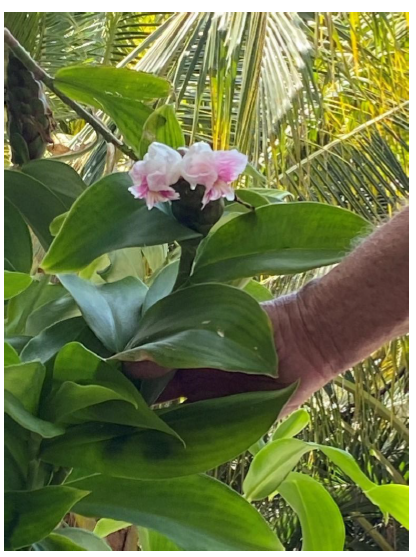By Tommy Clarkson on the April 2020 Edition
Family Zingiberaceae
Also known as None known
Few are the folks who don’t like the assorted flowers of Ginger! In Volume I of “The Civilized Jungle”, I wrote about the Shell Ginger (Alpinia zerumbet). In Volume II, it was the Red Ginger (Alpinia puepirata), Torch Ginger (Etlingera elatior) and White Ginger (Hedychiyum coronariuim).
With enthusiastic comments regarding our Scarlet Spiral Flag (Costus woodsonii), it seemed obvious I should also write about one of its kin, the Blushing Spiral Ginger. This species is also in the Costus genus, comprised of around forty-two genera of evergreen, perennial herbs, from tropical America and the West Indies. But remember, when selecting any Ginger species for your garden, be aware that, generally speaking, direct sunlight will burn their leaves.

As many know, there are other edible members in the Zingiberaceae family, such as cardamom, turmeric and galangal. But, before beginning to indiscriminately chow down on your plants, please take note that not all species of Ginger are of the eating sort. (Remember what your parents told you when you were little, “Don’t put everything in your mouth!”)
However, several that do have culinary application from what I’ve read, but few upon which I’ve actually munched, include : Mioga Ginger (Zingiber mioga), which has edible shoots and roots; Butterfly Ginger (Hedychium coronarium), that sports beautiful, edible flowers; and Zedoary (Curcuma zedoaria), of which almost every part is used as a spice; Cardamom Ginger (Alpinia calcarata), with an earthy flavor that is sometimes used like bay or cumin; Shell Ginger (Alpinia zerumbet), with its leaves that make a nice tasting tea; Torch Ginger (Etlingera ela-tior), with its unopened flower buds being quite flavorful; Red Button Ginger (Costus woodsonii), with edible yellow flowers that emerge from the red cones; as well as, of course, Common Ginger (Zingiber officinale) of which all of its parts may be eaten. But, with its coarse textured leaves, they’re not good in salads however, they’re quite delightful when used to season dishes or for making tea.
But, as sometimes happens, I seem to have sorta’ gotten a bit off track. “What of our subject plant, the Blushing Spiral Ginger (Costus talbotii,)” you ask, “can it be consumed?” Well, in all candor, so little has been written about it, I simply don’t know, and I am not prepared to be the Ginger chomping, guinea pig in determining its edibility!
According to the folks at Kew Gardens in London, this South-east Nigerian native is an “Herb with (a) wiry stem covered with long cylindrical ligules” (perhaps best described simply as a straplike structure.) It is similarly described by the African Plant Database, adding only that it is “epiphytic” (though ours is firmly rooted in terra firma) and has “ramose wiry stem[s].” Very “botanical” those comments! Conversely, those going on a “Tommy Tour” of our Ola Brisa Gardens that are lucky enough to see its strikingly attractive, short-lived bloom, are inclined to wax a bit more poetic!

pink blush and yellow markings on the labellum

The professionals in that second source add, “It can bloom either basally from the rhizome or laterally from the leaf axil. The stems, foliage and habit are very similar to Costus lateriflorus, but the flowers are quite different in color and shape white with a pink blush and yellow markings on the labellum and not so tubular at the base as Costus lateriflorus.” Kirsten Albrecht Llamas states in “Tropical Flowering Plants,” that this is a “rare Costus. Suitable for containers. Tender. Different from C. speciosus by smaller size and flower, not funnel shaped.” She adds that, while liking “regular moisture”, it also seeks “bright filtered sun.” (I agree. Ours does!)
Should you wish to grow one, I would suggest that it be grown in warm, humid conditions – year-round preferably – in very loose, fertile, well-draining soil, with light fertilization every couple of months or so.
While they can be propagated by leaf cuttings, the easiest way is to divide and plant pieces of the rhizome that are actively growing or which have just emerged from the soil.
The University of Florida Extension Service affirms this, adding that it is not “tolerant of cool temperatures . . . and requires loose, open, organic soil.
If planted too deep, it is prone to rot and should be raised slightly above grade on poorly draining soil.”
The full edition or view it online
—
Tommy Clarkson is a bit of a renaissance man. He’s lived and worked in locales as disparate as the 1.2 square mile island of Kwajalein to war-torn Iraq, from aboard he and Patty’s boat berthed out of Sea Bright, NJ to Thailand, Germany, Hawaii and Viet Nam; He’s taught classes and courses on creative writing and mass communications from the elementary grades to graduate level; He’s spoken to a wide array of meetings, conferences and assemblages on topics as varied as Buddhism, strategic marketing and tropical plants; In the latter category he and Patty’s recently book, “The Civilized Jungle” – written for the lay gardener – has been heralded as “the best tropical plant book in the last ten years”; And, according to Trip Advisor, their spectacular tropical creation – Ola Brisa Gardens – is the “Number One Tour destination in Manzanillo”.



